Galactic Center



The Galactic Center is the rotational center and the barycenter of the Milky Way.[1][2] Its central massive object is a supermassive black hole of about 4 million solar masses, which is called Sagittarius A*,[3][4][5] a compact radio source which is almost exactly at the galactic rotational center.[clarification needed] The Galactic Center is approximately 8 kiloparsecs (26,000 ly) away from Earth[3] in the direction of the constellations Sagittarius, Ophiuchus, and Scorpius, where the Milky Way appears brightest, visually close to the Butterfly Cluster (M6) or the star Shaula, south to the Pipe Nebula.
There are around 10 million stars within one parsec of the Galactic Center, dominated by red giants, with a significant population of massive supergiants and Wolf–Rayet stars from star formation in the region around 1 million years ago. The core stars are a small part within the much wider galactic bulge.
Discovery[edit]
Because of interstellar dust along the line of sight, the Galactic Center cannot be studied at visible, ultraviolet, or soft (low-energy) X-ray wavelengths. The available information about the Galactic Center comes from observations at gamma ray, hard (high-energy) X-ray, infrared, submillimetre, and radio wavelengths.
Immanuel Kant stated in Universal Natural History and Theory of the Heavens (1755) that a large star was at the center of the Milky Way Galaxy, and that Sirius might be the star.[6] Harlow Shapley stated in 1918 that the halo of globular clusters surrounding the Milky Way seemed to be centered on the star swarms in the constellation of Sagittarius, but the dark molecular clouds in the area blocked the view for optical astronomy.[7]
In the early 1940s Walter Baade at Mount Wilson Observatory took advantage of wartime blackout conditions in nearby Los Angeles, to conduct a search for the center with the 100-inch (250 cm) Hooker Telescope. He found that near the star Alnasl (Gamma Sagittarii), there is a one-degree-wide void in the interstellar dust lanes, which provides a relatively clear view of the swarms of stars around the nucleus of the Milky Way Galaxy.[8] This gap has been known as Baade's Window ever since.[9]
At Dover Heights in Sydney, Australia, a team of radio astronomers from the Division of Radiophysics at the CSIRO, led by Joseph Lade Pawsey, used "sea interferometry" to discover some of the first interstellar and intergalactic radio sources, including Taurus A, Virgo A and Centaurus A. By 1954 they had built an 80-foot (24 m) fixed dish antenna and used it to make a detailed study of an extended, extremely powerful belt of radio emission that was detected in Sagittarius. They named an intense point-source near the center of this belt Sagittarius A, and realised that it was located at the very center of the Galaxy, despite being some 32 degrees south-west of the conjectured galactic center of the time.[10]
In 1958 the International Astronomical Union (IAU) decided to adopt the position of Sagittarius A as the true zero coordinate point for the system of galactic latitude and longitude.[11] In the equatorial coordinate system the location is: RA 17h 45m 40.04s, Dec −29° 00′ 28.1″ (J2000 epoch).
In July 2022, astronomers reported the discovery of massive amounts of prebiotic molecules, including some associated with RNA, in the Galactic Center of the Milky Way Galaxy.[12][13]
Distance to the Galactic Center[edit]
The exact distance between the Solar System and the Galactic Center is not certain,[14] although estimates since 2000 have remained within the range 24–28.4 kilolight-years (7.4–8.7 kiloparsecs).[15] The latest estimates from geometric-based methods and standard candles yield the following distances to the Galactic Center:
- 7.4±0.2(stat) ± 0.2(syst) or 7.4±0.3 kpc (≈24±1 kly)[15]
- 7.62±0.32 kpc (≈24.8±1 kly)[16]
- 7.7±0.7 kpc (≈25.1±2.3 kly)[17]
- 7.94 or 8.0±0.5 kpc (≈26±1.6 kly)[18][19][20]
- 7.98±0.15(stat) ± 0.20(syst) or 8.0±0.25 kpc (≈26±0.8 kly)[21]
- 8.33±0.35 kpc (≈27±1.1 kly)[5]
- 8.0±0.3 kpc (≈25.96±0.98 kly)[22]
- 8.7±0.5 kpc (≈28.4±1.6 kly)[23]
- 8.122±0.031 kpc (≈26.49±0.1 kly)[24]
- 8.178±0.013(stat) ± 0.022(syst) kpc (≈26.67±0.1 kly)[3]
An accurate determination of the distance to the Galactic Center as established from variable stars (e.g. RR Lyrae variables) or standard candles (e.g. red-clump stars) is hindered by numerous effects, which include: an ambiguous reddening law; a bias for smaller values of the distance to the Galactic Center because of a preferential sampling of stars toward the near side of the Galactic bulge owing to interstellar extinction; and an uncertainty in characterizing how a mean distance to a group of variable stars found in the direction of the Galactic bulge relates to the distance to the Galactic Center.[25][26]
The nature of the Milky Way's bar, which extends across the Galactic Center, is also actively debated, with estimates for its half-length and orientation spanning between 1–5 kpc (short or a long bar) and 10–50°.[23][25][27] Certain authors advocate that the Milky Way features two distinct bars, one nestled within the other.[28] The bar is delineated by red-clump stars (see also red giant); however, RR Lyrae variables do not trace a prominent Galactic bar.[25][29][30] The bar may be surrounded by a ring called the 5-kpc ring that contains a large fraction of the molecular hydrogen present in the Milky Way, and most of the Milky Way's star formation activity. Viewed from the Andromeda Galaxy, it would be the brightest feature of the Milky Way.[31]
Supermassive black hole[edit]
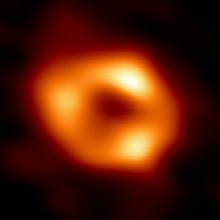
The complex astronomical radio source Sagittarius A appears to be located almost exactly at the Galactic Center and contains an intense compact radio source, Sagittarius A*, which coincides with a supermassive black hole at the center of the Milky Way. Accretion of gas onto the black hole, probably involving an accretion disk around it, would release energy to power the radio source, itself much larger than the black hole.
A study in 2008 which linked radio telescopes in Hawaii, Arizona and California (Very-long-baseline interferometry) measured the diameter of Sagittarius A* to be 44 million kilometers (0.3 AU).[4][33] For comparison, the radius of Earth's orbit around the Sun is about 150 million kilometers (1.0 AU), whereas the distance of Mercury from the Sun at closest approach (perihelion) is 46 million kilometers (0.3 AU). Thus, the diameter of the radio source is slightly less than the distance from Mercury to the Sun.
Scientists at the Max Planck Institute for Extraterrestrial Physics in Germany using Chilean telescopes have confirmed the existence of a supermassive black hole at the Galactic Center, on the order of 4.3 million solar masses.[5] Later studies have estimated a mass of 3.7 million[34][35] or 4.1 million solar masses.[24]
On 5 January 2015, NASA reported observing an X-ray flare 400 times brighter than usual, a record-breaker, from Sagittarius A*. The unusual event may have been caused by the breaking apart of an asteroid falling into the black hole or by the entanglement of magnetic field lines within gas flowing into Sagittarius A*, according to astronomers.[36]
Gamma- and X-ray emitting Fermi bubbles[edit]
In November 2010, it was announced that two large elliptical lobe structures of energetic plasma, termed bubbles, which emit gamma- and X-rays, were detected astride the Milky Way galaxy's core.[37] Termed Fermi or eRosita bubbles,[38] they extend up to about 25,000 light years above and below the Galactic Center.[37] The galaxy's diffuse gamma-ray fog hampered prior observations, but the discovery team led by D. Finkbeiner, building on research by G. Dobler, worked around this problem.[37] The 2014 Bruno Rossi Prize went to Tracy Slatyer, Douglas Finkbeiner, and Meng Su "for their discovery, in gamma rays, of the large unanticipated Galactic structure called the Fermi bubbles".[39]
The origin of the bubbles is being researched.[40][41] The bubbles are connected and seemingly coupled, via energy transport, to the galactic core by columnar structures of energetic plasma termed chimneys.[42] In 2020, for the first time, the lobes were seen in visible light[43] and optical measurements were made.[44] By 2022, detailed computer simulations further confirmed that the bubbles were caused by the Sagittarius A* black hole.[45][38]
Stellar population[edit]

The central cubic parsec around Sagittarius A* contains around 10 million stars.[46] Although most of them are old red giant stars, the Galactic Center is also rich in massive stars. More than 100 OB and Wolf–Rayet stars have been identified there so far.[47] They seem to have all been formed in a single star formation event a few million years ago. The existence of these relatively young stars was a surprise to experts, who expected the tidal forces from the central black hole to prevent their formation.[48]
This paradox of youth is even stronger for stars that are on very tight orbits around Sagittarius A*, such as S2 and S0-102. The scenarios invoked to explain this formation involve either star formation in a massive star cluster offset from the Galactic Center that would have migrated to its current location once formed, or star formation within a massive, compact gas accretion disk around the central black-hole. Current evidence favors the latter theory, as formation through a large accretion disk is more likely to lead to the observed discrete edge of the young stellar cluster at roughly 0.5 parsec.[49] Most of these 100 young, massive stars seem to be concentrated within one or two disks, rather than randomly distributed within the central parsec.[50][51] This observation however does not allow definite conclusions to be drawn at this point.
Star formation does not seem to be occurring currently at the Galactic Center, although the Circumnuclear Disk of molecular gas that orbits the Galactic Center at two parsecs seems a fairly favorable site for star formation. Work presented in 2002 by Antony Stark and Chris Martin mapping the gas density in a 400-light-year region around the Galactic Center has revealed an accumulating ring with a mass several million times that of the Sun and near the critical density for star formation.
They predict that in approximately 200 million years, there will be an episode of starburst in the Galactic Center, with many stars forming rapidly and undergoing supernovae at a hundred times the current rate. This starburst may also be accompanied by the formation of galactic relativistic jets, as matter falls into the central black hole. It is thought that the Milky Way undergoes a starburst of this sort every 500 million years.
In addition to the paradox of youth, there is a "conundrum of old age" associated with the distribution of the old stars at the Galactic Center. Theoretical models had predicted that the old stars—which far outnumber young stars—should have a steeply-rising density near the black hole, a so-called Bahcall–Wolf cusp. Instead, it was discovered in 2009 that the density of the old stars peaks at a distance of roughly 0.5 parsec from Sgr A*, then falls inward: instead of a dense cluster, there is a "hole", or core, around the black hole.[52]
Several suggestions have been put forward to explain this puzzling observation, but none is completely satisfactory.[53][54] For instance, although the black hole would eat stars near it, creating a region of low density, this region would be much smaller than a parsec. Because the observed stars are a fraction of the total number, it is theoretically possible that the overall stellar distribution is different from what is observed, although no plausible models of this sort have been proposed yet.
Gallery[edit]
In May 2021, NASA published new images of the Galactic Center, based on surveys from Chandra X-ray Observatory and other telescopes.[55] Images are about 2.2 degrees (1,000 light years) across and 4.2 degrees (2,000 light years) long.
-
A small portion of a gigapixel color mosaic of the Milky Way's heart.[56]
-
Red giant stars coexist with white, Sun-like stars.[57]
-
White Dwarfs in Milky Way's Central Hub.[58]
-
The center of the Milky Way – image taken by ISAAC, the VLT's near- and mid-infrared spectrometer and camera.
-
Infrared image from Spitzer Space Telescope.
-
A view of the night sky near Sagittarius, enhanced to show better contrast and detail in the dust lanes. The principal stars in Sagittarius are indicated in red.
-
The central parts of the Milky Way, as observed in the near-infrared with the NACO instrument on ESO's Very Large Telescope.
-
Infra-red image of the center of the Milky Way revealing a new population of massive stars.
-
Detection of an unusually bright X-ray flare from Sagittarius A*, a supermassive black hole in the center of the Milky Way galaxy.[36]
-
The center of the Milky Way, as imaged by 64 radio telescopes of the South African MeerKAT array.
See also[edit]
Notes and references[edit]
- ^ Overbye, Dennis (31 January 2022). "An Electrifying View of the Heart of the Milky Way – A new radio-wave image of the center of our galaxy reveals all the forms of frenzy that a hundred million or so stars can get up to". The New York Times. Retrieved 1 February 2022.
- ^ Heywood, I.; et al. (28 January 2022). "The 1.28 GHZ MeerKAT Galactic Center Mosaic". The Astrophysical Journal. 925 (2): 165. arXiv:2201.10541. Bibcode:2022ApJ...925..165H. doi:10.3847/1538-4357/ac449a. S2CID 246275657.
- ^ a b c R. Abuter; A. Amorim; M. Bauböck; J. P. Berger; H. Bonnet; W. Brandner; et al. (The GRAVITY collaboration) (April 2019). "A geometric distance measurement to the Galactic center black hole with 0.3% uncertainty". Astronomy & Astrophysics. 625: L10. arXiv:1904.05721. Bibcode:2019A&A...625L..10G. doi:10.1051/0004-6361/201935656. S2CID 119190574.
- ^ a b Doeleman, Sheperd S.; et al. (2008). "Event-horizon-scale structure in the supermassive black hole candidate at that Galactic Centre". Nature. 455 (7209): 78–80. arXiv:0809.2442. Bibcode:2008Natur.455...78D. doi:10.1038/nature07245. PMID 18769434. S2CID 4424735.
- ^ a b c Gillessen, S.; Eisenhauer; Trippe; Alexander; Genzel; Martins; Ott (2009). "Monitoring Stellar Orbits Around the Massive Black Hole in the Galactic Center". The Astrophysical Journal. 692 (2): 1075–1109. arXiv:0810.4674. Bibcode:2009ApJ...692.1075G. doi:10.1088/0004-637X/692/2/1075. S2CID 1431308.
- ^ Ley, Willy (August 1965). "The Galactic Giants". For Your Information. Galaxy Science Fiction. pp. 130–142.
- ^ Shapley, H (1918). "Studies based on the colors and magnitudes in stellar clusters. VII. The distances, distribution in space, and dimensions of 69 globular clusters". The Astrophysical Journal. 48: 154. Bibcode:1918ApJ....48..154S. doi:10.1086/142423.
- ^ Baade, W (1946). "A Search for the Nucleus of Our Galaxy". Publications of the Astronomical Society of the Pacific. 58 (343): 249. Bibcode:1946PASP...58..249B. doi:10.1086/125835.
- ^ Ng, Y. K; Bertelli, G; Chiosi, C; Bressan, A (1996). "The galactic structure towards the Galactic Center. III. A study of Baade's Window: Discovery of the bar population?". Astronomy and Astrophysics. 310: 771. Bibcode:1996A&A...310..771N.
- ^ Pawsey, J. L (1955). "A Catalogue of Reliably Known Discrete Sources of Cosmic Radio Waves". The Astrophysical Journal. 121: 1. Bibcode:1955ApJ...121....1P. doi:10.1086/145957.
- ^ Blaauw, A.; Gum, C.S.; Pawsey, J.L.; Westerhout, G. (1960). "The new IAU system of galactic coordinates (1958 revision)". Monthly Notices of the Royal Astronomical Society. 121 (2): 123–131. Bibcode:1960MNRAS.121..123B. doi:10.1093/mnras/121.2.123.
- ^ Starr, Michelle (8 July 2022). "Loads of Precursors For RNA Have Been Detected in The Center of Our Galaxy". ScienceAlert. Retrieved 9 July 2022.
- ^ Rivilla, Victor M.; et al. (8 July 2022). "Molecular Precursors of the RNA-World in Space: New Nitriles in the G+0.693-0.027 Molecular Cloud". Frontiers in Astronomy and Space Sciences. 9. arXiv:2206.01053. doi:10.3389/fspas.2022.876870.
- ^ Malkin, Zinovy M. (February 2013). "Analysis of Determinations of the Distance between the Sun and the Galactic Center". Astronomy Reports. 57 (2): 128–133. arXiv:1301.7011. Bibcode:2013ARep...57..128M. CiteSeerX 10.1.1.766.631. doi:10.1134/S1063772913020078. S2CID 55662712. Russian original Малкин, З. М. (2013). "Об определении расстояния от Солнца до центра Галактики". Astronomicheskii Zhurnal (in Russian). 90 (2): 152–157. doi:10.7868/S0004629913020072.
- ^ a b Francis, Charles; Anderson, Erik (June 2014). "Two estimates of the distance to the Galactic Centre". Monthly Notices of the Royal Astronomical Society. 441 (2): 1105–1114. arXiv:1309.2629. Bibcode:2014MNRAS.441.1105F. doi:10.1093/mnras/stu631. S2CID 119235554.
- ^ Eisenhauer, F.; Genzel, R.; Alexander, T.; Abuter, R.; Paumard, T.; Ott, T.; Gilbert, A.; Gillessen, S.; Horrobin, M.; Trippe, S.; Bonnet, H.; Dumas, C.; Hubin, N.; Kaufer, A.; Kissler-Patig, M.; Monnet, G.; Ströbele, S.; Szeifert, T.; Eckart, A.; Schödel, R.; Zucker, S. (2005). "SINFONI in the Galactic Center: Young Stars and Infrared Flares in the Central Light-Month". The Astrophysical Journal. 628 (1): 246–259. arXiv:astro-ph/0502129. Bibcode:2005ApJ...628..246E. doi:10.1086/430667. S2CID 122485461.
- ^ Majaess, D.J.; Turner, D.G.; Lane, D.J. (2009). "Characteristics of the Galaxy according to Cepheids". MNRAS. 398 (1): 263–270. arXiv:0903.4206. Bibcode:2009MNRAS.398..263M. doi:10.1111/j.1365-2966.2009.15096.x. S2CID 14316644.
- ^ Reid, Mark J. (1993). "The distance to the center of the Galaxy". Annual Review of Astronomy and Astrophysics. 31 (1): 345–372. Bibcode:1993ARA&A..31..345R. doi:10.1146/annurev.aa.31.090193.002021.
- ^ Eisenhauer, F.; Schödel, R.; Genzel, R.; Ott, T.; Tecza, M.; Abuter, R.; Eckart, A.; Alexander, T. (2003). "A Geometric Determination of the Distance to the Galactic Center". The Astrophysical Journal. 597 (2): L121–L124. arXiv:astro-ph/0306220. Bibcode:2003ApJ...597L.121E. doi:10.1086/380188. S2CID 16425333.
- ^ Horrobin, M.; Eisenhauer, F.; Tecza, M.; Thatte, N.; Genzel, R.; Abuter, R.; Iserlohe, C.; Schreiber, J.; Schegerer, A.; Lutz, D.; Ott, T.; Schödel, R. (2004). "First results from SPIFFI. I: The Galactic Center" (PDF). Astronomische Nachrichten. 325 (2): 120–123. Bibcode:2004AN....325...88H. doi:10.1002/asna.200310181. Archived from the original (PDF) on 21 June 2007.
- ^ Malkin, Zinovy (2012). "The current best estimate of the Galactocentric distance of the Sun based on comparison of different statistical techniques". arXiv:1202.6128 [astro-ph.GA].
- ^ Camarillo, T.; Mathur; Mitchell; Ratra (2018). "Median Statistics Estimate of the Distance to the Galactic Center". Publications of the Astronomical Society of the Pacific. 130 (984): 024101. arXiv:1708.01310. Bibcode:2018PASP..130b4101C. doi:10.1088/1538-3873/aa9b26. S2CID 118936491.
- ^ a b Vanhollebeke, E.; Groenewegen, M. A. T.; Girardi, L. (April 2009). "Stellar populations in the Galactic bulge. Modelling the Galactic bulge with TRILEGAL". Astronomy and Astrophysics. 498 (1): 95–107. arXiv:0903.0946. Bibcode:2009A&A...498...95V. doi:10.1051/0004-6361/20078472. S2CID 125177722.
- ^ a b Abuter, R.; Amorim, A.; Anugu, N.; Bauböck, M.; Benisty, M.; Berger, J. P.; Blind, N.; Bonnet, H.; Brandner, W.; Buron, A.; Collin, C.; Chapron, F.; Clénet, Y.; Foresto, V. dCoudé u; Zeeuw, P. T. de; Deen, C.; Delplancke-Ströbele, F.; Dembet, R.; Dexter, J.; Duvert, G.; Eckart, A.; Eisenhauer, F.; Finger, G.; Schreiber, N. M. Förster; Fédou, P.; Garcia, P.; Lopez, R. Garcia; Gao, F.; Gendron, E.; Genzel, R.; Gillessen, S.; Gordo, P.; Habibi, M.; Haubois, X.; Haug, M.; Haußmann, F.; Henning, Th; Hippler, S.; Horrobin, M.; Hubert, Z.; Hubin, N.; Rosales, A. Jimenez; Jochum, L.; Jocou, L.; Kaufer, A.; Kellner, S.; Kendrew, S.; Kervella, P.; Kok, Y.; Kulas, M.; Lacour, S.; Lapeyrère, V.; Lazareff, B.; Bouquin, J.-B. Le; Léna, P.; Lippa, M.; Lenzen, R.; Mérand, A.; Müler, E.; Neumann, U.; Ott, T.; Palanca, L.; Paumard, T.; Pasquini, L.; Perraut, K.; Perrin, G.; Pfuhl, O.; Plewa, P. M.; Rabien, S.; Ramírez, A.; Ramos, J.; Rau, C.; Rodríguez-Coira, G.; Rohloff, R.-R.; Rousset, G.; Sanchez-Bermudez, J.; Scheithauer, S.; Schöller, M.; Schuler, N.; Spyromilio, J.; Straub, O.; Straubmeier, C.; Sturm, E.; Tacconi, L. J.; Tristram, K. R. W.; Vincent, F.; Fellenberg, S. von; Wank, I.; Waisberg, I.; Widmann, F.; Wieprecht, E.; Wiest, M.; Wiezorrek, E.; Woillez, J.; Yazici, S.; Ziegler, D.; Zins, G. (1 July 2018). "Detection of the gravitational redshift in the orbit of the star S2 near the Galactic centre massive black hole". Astronomy & Astrophysics. 615: L15. arXiv:1807.09409. Bibcode:2018A&A...615L..15G. doi:10.1051/0004-6361/201833718. hdl:10871/35577. S2CID 118891445.
- ^ a b c Majaess, D (March 2010). "Concerning the Distance to the Center of the Milky Way and Its Structure". Acta Astronomica. 60 (1): 55–74. arXiv:1002.2743. Bibcode:2010AcA....60...55M.
- ^ Vovk, Olga (27 April 2011). "Milky Way: Distance to the Galactic Centre". Universe at a glance (blog). Retrieved 23 March 2019.
- ^ Cabrera-Lavers, A.; González-Fernández, C.; Garzón, F.; Hammersley, P. L.; López-CorredoiRA, M. (December 2008). "The long Galactic bar as seen by UKIDSS Galactic plane survey". Astronomy and Astrophysics. 491 (3): 781–787. arXiv:0809.3174. Bibcode:2008A&A...491..781C. doi:10.1051/0004-6361:200810720. S2CID 15040792.
- ^ Nishiyama, Shogo; Nagata, Tetsuya; Baba, Daisuke; Haba, Yasuaki; Kadowaki, Ryota; Kato, Daisuke; Kurita, Mikio; Nagashima, Chie; Nagayama, Takahiro; Murai, Yuka; Nakajima, Yasushi; TamuRA, Motohide; Nakaya, Hidehiko; Sugitani, Koji; Naoi, Takahiro; Matsunaga, Noriyuki; Tanabé, Toshihiko; Kusakabe, Nobuhiko; Sato, Shuji (March 2005). "A Distinct Structure inside the Galactic Bar". The Astrophysical Journal. 621 (2): L105–L108. arXiv:astro-ph/0502058. Bibcode:2005ApJ...621L.105N. doi:10.1086/429291. S2CID 399710.
- ^ Alcock, C.; Allsman, R. A.; Alves, D. R.; Axelrod, T. S.; Becker, A. C.; Basu, A.; Baskett, L.; Bennett, D. P.; Cook, K. H.; Freeman, K. C.; Griest, K.; Guern, J. A.; Lehner, M. J.; Marshall, S. L.; Minniti, D.; Peterson, B. A.; Pratt, M. R.; Quinn, P. J.; Rodgers, A. W.; Stubbs, C. W.; Sutherland, W.; Vandehei, T.; Welch, D. L. (January 1998). "The RR Lyrae Population of the Galactic Bulge from the MACHO Database: Mean Colors and Magnitudes". The Astrophysical Journal. 492 (1): 190–199. arXiv:astro-ph/9706292. Bibcode:1998ApJ...492..190A. doi:10.1086/305017. S2CID 16244436.
- ^ Kunder, Andrea; Chaboyer, Brian (December 2008). "Metallicity Analysis of MACHO Galactic Bulge RR0 Lyrae Stars from their Light Curves". The Astronomical Journal. 136 (6): 2441–2452. arXiv:0809.1645. Bibcode:2008AJ....136.2441K. doi:10.1088/0004-6256/136/6/2441. S2CID 16046532.
- ^ Staff (12 September 2005). "Introduction: Galactic Ring Survey". Boston University. Retrieved 10 May 2007.
- ^ "Astronomers reveal first image of the black hole at the heart of our galaxy". Event Horizon Telescope. Archived from the original on 12 May 2022. Retrieved 12 May 2022.
- ^ Reynolds, Christopher S. (2008). "Bringing black holes into focus". Nature. 455 (7209): 39–40. Bibcode:2008Natur.455...39R. doi:10.1038/455039a. PMID 18769426. S2CID 205040663.
- ^ Ghez, A. M.; Salim, S.; Hornstein, S. D.; Tanner, A.; Lu, J. R.; Morris, M.; Becklin, E. E.; Duchene, G. (20 February 2005). "Stellar Orbits around the Galactic Center Black Hole". The Astrophysical Journal. 620 (2): 744–757. arXiv:astro-ph/0306130. Bibcode:2005ApJ...620..744G. doi:10.1086/427175. S2CID 8656531.
- ^ Schödel, R.; Ott, T.; Genzel, R.; Hofmann, R.; Lehnert, M.; Eckart, A.; Mouawad, N.; Alexander, T.; Reid, M. J.; Lenzen, R.; Hartung, M.; Lacombe, F.; Rouan, D.; Gendron, E.; Rousset, G.; Lagrange, A.-M.; Brandner, W.; Ageorges, N.; Lidman, C.; Moorwood, A. F. M.; Spyromilio, J.; Hubin, N.; Menten, K. M. (October 2002). "A star in a 15.2-year orbit around the supermassive black hole at the centre of the Milky Way". Nature. 419 (6908): 694–696. arXiv:astro-ph/0210426. Bibcode:2002Natur.419..694S. doi:10.1038/nature01121. PMID 12384690. S2CID 4302128.
- ^ a b Chou, Felicia; Anderson, Janet; Watzke, Megan (5 January 2015). "Release 15-001 – NASA's Chandra Detects Record-Breaking Outburst from Milky Way's Black Hole". NASA.
- ^ a b c Aguilar, David A.; Pulliam, Christine (9 November 2010). "Astronomers Find Giant, Previously Unseen Structure in our Galaxy". Harvard-Smithsonian Center for Astrophysics. Release No. 2010-22.
- ^ a b Yang, H.-Y. Karen; Ruszkowski, Mateusz; Zweibel, Ellen G. (7 March 2022). "Fermi and eROSITA bubbles as relics of the past activity of the Galaxy's central black hole". Nature Astronomy. 6 (5). Springer Nature: 584–591. arXiv:2203.02526. Bibcode:2022NatAs...6..584Y. doi:10.1038/s41550-022-01618-x. ISSN 2397-3366. S2CID 247292361.
- ^ "2014 Rossi prize awarded to Douglas Finkbeiner, Tracy Slatyer, and Meng Su". Harvard University. 8 January 2014.
- ^ Yang, H.-Y. K.; Ruszkowski, M.; Zweibel, E. G. (12 February 2018). "Unveiling the Origin of the Fermi Bubbles". Galaxies. 6 (29): 29. arXiv:1802.03890. Bibcode:2018Galax...6...29Y. doi:10.3390/galaxies6010029. S2CID 56443272.
- ^ Liu, Jia (15 May 2020). "Researchers reveal common origin of Fermi bubbles and galactic center X-ray outflows". Phys.org. Science X Network.
- ^ Chernyakova, Masha (20 March 2019). "X-ray chimneys in the Galactic Centre". Nature. 567 (7748). Springer Nature Publishing: 318–320. Bibcode:2019Natur.567..318C. doi:10.1038/d41586-019-00811-9. PMID 30894730.
- ^ Krishnarao, Dhanesh; Benjamin, Robert A.; Haffner, L. Matthew (7 August 2020). "Discovery of High-velocity Hα Emission in the Direction of the Fermi Bubble". The Astrophysical Journal. 899 (1): L11. arXiv:2006.00010. Bibcode:2020ApJ...899L..11K. doi:10.3847/2041-8213/aba8f0. S2CID 220969030.
- ^ "236th Meeting of the American Astronomical Society". www.abstractsonline.com. Retrieved 8 June 2020.
- ^ University of Michigan (8 March 2022). "Massive bubbles at center of Milky Way caused by supermassive black hole". Phys.org. Science X Network.
- ^ "Lecture 31: The Center of Our Galaxy".
- ^ Mauerhan, J. C.; Cotera, A.; Dong, H. (2010). "Isolated Wolf–Rayet Stars and O Supergiants in the Galactic Center Region Identified Via Paschen-α Excess". The Astrophysical Journal. 725 (1): 188–199. arXiv:1009.2769. Bibcode:2010ApJ...725..188M. doi:10.1088/0004-637X/725/1/188. S2CID 20968628.
- ^ Støstad, M.; Do, T.; Murray, N.; Lu, J.R.; Yelda, S.; Ghez, A. (2015). "Mapping the Outer Edge of the Young Stellar Cluster in the Galactic Center". The Astrophysical Journal. 808 (2): 106. arXiv:1504.07239. Bibcode:2015ApJ...808..106S. doi:10.1088/0004-637X/808/2/106. S2CID 118579717.
- ^ Støstad, M.; Do, T.; Murray, N.; Lu, J.R.; Yelda, S.; Ghez, A. (2015). "Mapping the Outer Edge of the Young Stellar Cluster in the Galactic Center". The Astrophysical Journal. 808 (2): 106. arXiv:1504.07239. Bibcode:2015ApJ...808..106S. doi:10.1088/0004-637X/808/2/106. S2CID 118579717.
- ^ "UCLA Galactic Center Group". Archived from the original on 26 June 2017. Retrieved 9 November 2007.
- ^ "Galactic Center".
- ^ Buchholz, R. M.; Schödel, R.; Eckart, A. (May 2009). "Composition of the galactic center star cluster: Population analysis from adaptive optics narrow band spectral energy distributions". Astronomy and Astrophysics. 499 (2): 483–501. arXiv:0903.2135. Bibcode:2009A&A...499..483B. doi:10.1051/0004-6361/200811497. S2CID 5221750.
- ^ Merritt, David (May 2011). Morris, Mark; Wang, Daniel Q.; Yuan, Feng (eds.). "Dynamical Models of the Galactic Center". The Galactic Center: A Window to the Nuclear Environment of Disk Galaxies. The Galactic Center: A Window on the Nuclear Environment of Disk Galaxies. 439. San Francisco: 142. arXiv:1001.5435. Bibcode:2011ASPC..439..142M.
- ^ Chown, Marcus (September 2010). "Something's been eating the stars". New Scientist. 207 (2778): 30–33. Bibcode:2010NewSc.207...30M. doi:10.1016/S0262-4079(10)62278-6. Archived from the original on 9 December 2014. Retrieved 9 September 2017.
- ^ Wang, Q. Daniel (2021). "Chandra large-scale mapping of the Galactic Centre: Probing high-energy structures around the central molecular zone". Monthly Notices of the Royal Astronomical Society. 504 (2): 1609–1618. arXiv:2010.02932. doi:10.1093/mnras/stab801.
- ^ "Lights out in the galactic centre". www.eso.org. Retrieved 30 April 2018.
- ^ "Hubble captures glittering crowded hub of our Milky Way". www.spacetelescope.org. Retrieved 15 January 2018.
- ^ "Hubble Spots White Dwarfs in Milky Way's Central Hub". Retrieved 9 November 2015.
Further reading[edit]
- Eckart, A.; Schödel, R.; Straubmeier, C. (2005). The Black Hole at the Center of the Milky Way. London: Imperial College Press. ISBN 978-1-86094-567-0.
- Melia, Fulvio (2003). The Black Hole in the Center of Our Galaxy. Princeton: Princeton University Press. ISBN 978-0-691-09505-9.
- Melia, Fulvio (2007). The Galactic Supermassive Black Hole. Princeton: Princeton University Press. ISBN 978-0-691-13129-0.
Press
- "New MeerKAT radio image reveals complex heart of the Milky Way – SARAO". 26 January 2022.
External links[edit]
- UCLA Galactic Center Group Archived 26 June 2017 at the Wayback Machine
- Max Planck Institute for Extraterrestrial Physics Galactic Center Group
- The Galactic Supermassive Black Hole
- The Black Hole at the Center of the Milky Way
- The dark heart of the Milky Way
- Animation showing orbits of stars near the center of the Milky Way galaxy
- Zooming in on the center of the Milky Way
- Dramatic Increase in Supernova Explosions Looms
- APOD:
- A simulation of the stars orbiting the Milky Way's central massive black hole
- Galactic Center on arxiv.org


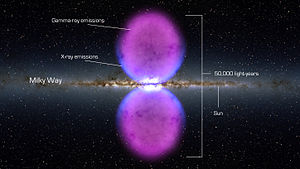


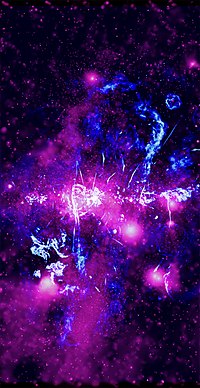

![A small portion of a gigapixel color mosaic of the Milky Way's heart.[56]](http://upload.wikimedia.org/wikipedia/commons/thumb/8/80/Lights_out_in_the_galactic_centre.jpg/261px-Lights_out_in_the_galactic_centre.jpg)
![Red giant stars coexist with white, Sun-like stars.[57]](http://upload.wikimedia.org/wikipedia/commons/thumb/5/55/Hubble_captures_glittering_crowded_hub_of_our_Milky_Way.jpg/213px-Hubble_captures_glittering_crowded_hub_of_our_Milky_Way.jpg)
![White Dwarfs in Milky Way's Central Hub.[58]](http://upload.wikimedia.org/wikipedia/commons/thumb/e/eb/Hubble_Spots_White_Dwarfs_in_Milky_Way%27s_Central_Hub.jpg/225px-Hubble_Spots_White_Dwarfs_in_Milky_Way%27s_Central_Hub.jpg)
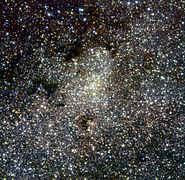
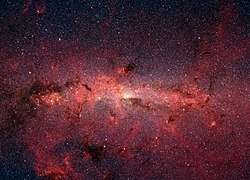


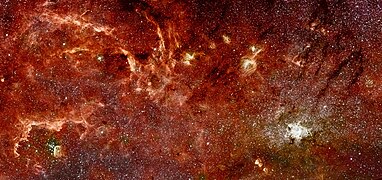
![Detection of an unusually bright X-ray flare from Sagittarius A*, a supermassive black hole in the center of the Milky Way galaxy.[36]](http://upload.wikimedia.org/wikipedia/commons/thumb/8/85/X-RayFlare-BlackHole-MilkyWay-20140105.jpg/180px-X-RayFlare-BlackHole-MilkyWay-20140105.jpg)


